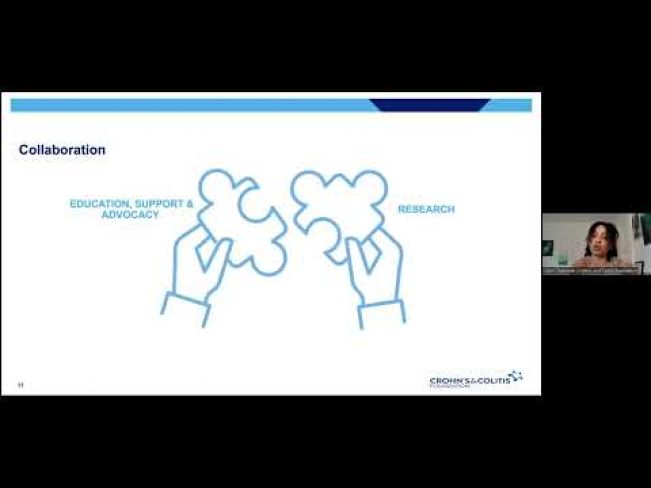
How are patient organizations taking on the challenge of diversity, equity, and inclusion within biomedical research to create better health outcomes for all patient populations, especially those historically excluded from research and underserved in care, treatments, and cures? As part of The Research Acceleration and Innovation Network (TRAIN) webinar series, FasterCures takes a deeper dive into the health equity initiatives at three different foundations: the Crohn’s & Colitis Foundation, the Lupus Research Alliance, and the Foundation for Sarcoidosis Research. Their presentations offered lessons learned and best practices that can be modeled by other patient organizations hoping to improve their efforts to improve diversity and representation in research.

Moderator
Christina Hochul
Senior Director, Head of Strategic Alliance Development, Alexion, AstraZeneca Rare Disease
Speakers
Carol Chapman
Senior Manager, Research Engagement, the Crohn’s & Colitis Foundation
Claire Finney
Project Manager, Health Equity, the Lupus Research Alliance
Mary McGowan
Chief Executive Officer, the Foundation for Sarcoidosis Research
Summary
Coinciding with a time of intense awareness around issues of racial injustice in the US, the COVID-19 pandemic focused the public’s attention on racial and ethnic disparities in health outcomes, access to health care, and trust and participation in research to an extent likely never seen before. FasterCures is driving a focus on representation and diversity within the biomedical research ecosystem. Through The Research Acceleration and Innovation Network (TRAIN), FasterCures aims to provide resources and opportunities for patient organizations to learn from each other to progress toward a system that is accessible and welcoming for all patients. To explore such issues, Christina Hochul (senior director and head of strategic alliance development for Alexion and AstraZeneca Rare Disease) moderated a TRAIN webinar featuring Carol Chapman (senior manager of research engagement for the Crohn’s & Colitis Foundation), Claire Finney (project manager for health equity at the Lupus Research Alliance), and Mary McGowan (CEO of the Foundation for Sarcoidosis Research) to share how their organizations are working to foster a diverse and inclusive research environment; access a broader range of perspectives, ideas, and knowledge; and drive innovation in improving patient outcomes.
The panelists discussed active initiatives their organizations are implementing to include diverse, underrepresented stakeholder voices at the table, build trust within patient communities, improve health outcomes for those disproportionately affected by disease, and increase diverse representation within clinical trials. Presentations highlighted the implementation process, challenges, and lessons learned associated with such initiatives.
Importance of Patient Engagement and Amplifying Patient Voice
Each presenter discussed initiatives within their diversity and representation portfolios to improve patient engagement and include patients as valued stakeholders, especially those from underserved communities. A core element stressed was treating patients as leaders, not tokens. Speakers noted the importance of involving patients in as many aspects of the R&D process as possible and considering them “experts” on their condition rather than patients providing feedback. One presenter highlighted a strategy to amplify patient voice by creating patient advisory boards where the patient is brought into the drug development process as a partner, and their expressed needs and preferences are prioritized. According to the three speakers, not only should patient-expressed needs be prioritized, but clinical research barriers and disparities from the patient perspective should be emphasized, and patients should work in tandem with researchers and organization leaders to develop patient-centric solutions.
To engage patients as experienced experts and leaders of the inflammatory bowel disease (IBD) community, the Crohn’s and Colitis Foundation (CCF) includes patients and caregivers as key opinion leaders when setting their research department strategies. The Challenges in IBD Research Project’s goal is to utilize patient input from a diverse group of patients and caregivers alongside clinical and scientific leaders to identify unmet needs in the IBD research field and develop a plan to address those needs over a five-year period. Similar patient engagement work is being pursued at the Lupus Research Alliance (LRA) through their Patient Advocates for Lupus Studies (PALS) program. This initiative involves peer-to-peer early education intervention to improve clinical trial participation. LRA found that people who completed the PALS program demonstrated significant increases in knowledge about, attitudes towards, and intention to participate in lupus clinical trials after completing the PALS program. Other patient organizations could replicate these initiatives to increase patient engagement with historically excluded and underserved populations to ensure all patient voices are heard and equitably considered through the biomedical R&D process.
Improving Transparency and Building Trust with Underrepresented Groups
When the speakers were asked about the first steps to engage with diverse disease communities, all of them stressed the importance of building trust through transparency and communication. Advice to build this trust included:
-
building relationships with communities first before making an ask of them (or even without the intention of making an ask),
-
becoming a trusted source of information through high levels of transparency,
-
working and collaborating with education and support advocacy groups who have an existing strong and trusted relationship with the communities, and
-
maintaining strong communication among all stakeholders, including patients, researchers, clinicians, and institutions
Carol Chapman with CCF emphasized the need to be explicit and specific about why a patient should be in a study and what is being done with their data. She highlighted that relationships go both ways and historically it is the health-care organizations that lack transparency, not the patients. Part of CCF’s work to increase transparency and build trust within the Crohn’s and colitis community includes its diversity and inclusion education, support, and advocacy initiatives. Some examples of this work include partnering with Morehouse School of Medicine and Charles Drew College to create videos about IBD, engaging with the communities through a trusted source, connecting Black/African American and Hispanic/Latinx IBD experts with patients and caregivers from those communities, and instituting education breakout sessions focused on topics patients deem important.
The Foundation for Sarcoidosis Research (FSR) is also using education and awareness tactics to build a trusted relationship with its patient communities. Mary McGowan highlighted that African American women (AAW) with sarcoidosis have the highest prevalence of disease and worst outcomes. To address this, FSR instituted the Ignore No More campaign. This campaign focuses on raising awareness and education about sarcoidosis among AAW, increasing understanding of risks and barriers, and expanding earlier diagnosis and better disease management among AAW. Mary noted that this campaign received some negative feedback from the sarcoidosis community with some individuals feeling they were excluded given that the campaign was aimed specifically at the AAW community. FSR used this as an opportunity to listen and recognize FSR leadership bias, assess and adjust their messaging, and provide resources on the science backing the program. From this setback, FSR learned valuable lessons, including:
-
Don’t assume motive.
-
Data doesn’t always convince people.
-
Don’t be discouraged.
-
Don’t lose the campaign’s integrity.
-
Inform, don’t convince.
These lessons are valuable steps to consider before patient organizations launch programs aimed at specific populations within the patient communities. Clear communication with the entire patient population helps maintain transparency and strengthen trust.
Diversifying Research to Improve Outcomes for Those Disproportionately Impacted by Disease
Throughout the presentations, all the speakers underscored that underserved communities tend to suffer disproportionately negative disease outcomes and emphasized the need to engage with communities that have been historically underrepresented in research. Speakers presented several ways to increase diversity and representation within research and clinical trial participation. These include:
-
assessing the prevalence and incidence, outcomes differences, and gaps in care;
-
diversifying internal leadership, such as the Board, staff, and Patient Advisory Council;
-
listening to and forming key partnerships with clinicians and researchers, experts, hospitals, Patient Advisory Committees, community-based organizations, non-profits and coalitions, and pharmaceutical companies;
-
participating in and conducting comprehensive community outreach; and
-
addressing systemic challenges, such as investigator bias and medical mistrust, contributing to a lack of diversity and inclusivity in clinical trials.
FSR is working to understand why more Black community members are not enrolling in research through Phase II of their Ignore No More campaign. The Advance Clinical Trials for Equity in Sarcoidosis campaign, or ACTe Now!, plans to hold key opinion leadership meetings, patient focus groups, and release a white paper and congressional briefing. Through this campaign, FSR intends to create a diagnostic and referral framework for historically underserved populations, conduct a pilot test utilizing that framework, and finally develop recommendations on how to improve care and treatment for Black Americans in the sarcoidosis community.
LRA is also working on efforts to improve health outcomes for underserved populations. Through Project CHANGE, LRA is striving to improve diversity and representation in lupus clinical trials from Black/African American communities living with lupus. They hope to accomplish this by building lupus research collaboratives which will serve as grassroots coalitions in three local communities where they will engage faith-based organizations, community-based organizations, non-traditional stakeholders, people living with lupus, and community-based health-care clinics to unite and develop an action plan aimed at increasing lupus clinical trial access and inclusion. Patient organizations can apply strategies outlined in these approaches such as creating grassroots coalitions, engaging community organizations and members, or undertaking research campaigns exploring barriers preventing underrepresented groups from participating in research to develop strategies to engage more diverse populations in clinical research.
Conclusion
These three foundation leaders shared a variety of approaches they are taking to bring leadership, resources, and cohesive plans to set priorities and create accountability for not only themselves but other stakeholders in the ecosystem. From their initiatives and work in this space, a few universal lessons arose which can be transferred to any patient organization hoping to improve and amplify diversity and inclusion in the biomedical R&D ecosystem.
First, it is essential to follow what the science is conveying about the disease space and the gaps and needs within research. Second, the patient voice must always be kept at the center of all work and diverse patient voices should always have a substantial seat at the table. Third, maintaining strong communication will improve transparency and allow patient organizations to be trusted sources of information for all within the patient populations. Fourth, building a strong relationship with the patient communities must be done before any work or ask can be made. And fifth, collaboration and leaning on partnerships are key to having a strong impact and initiating change.
Patient organizations instituting these universal lessons and continuing to learn from each other’s diversity and representation initiatives will help create systems change and improve outcomes and experiences within R&D for all patients, especially those disproportionately impacted by disease outcomes. Enhancing diversity and representation in research is critical, long-term, and difficult work without shortcuts, and we must all learn from each other to move forward.



